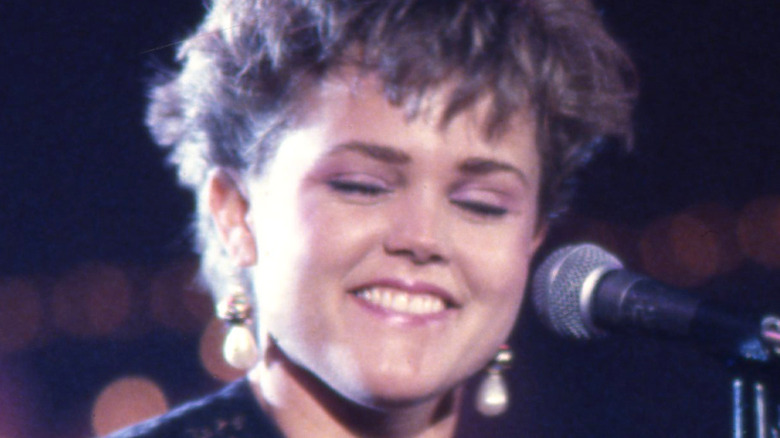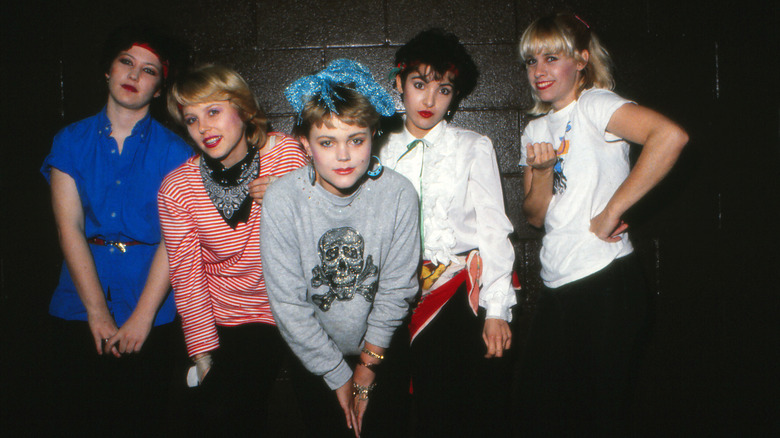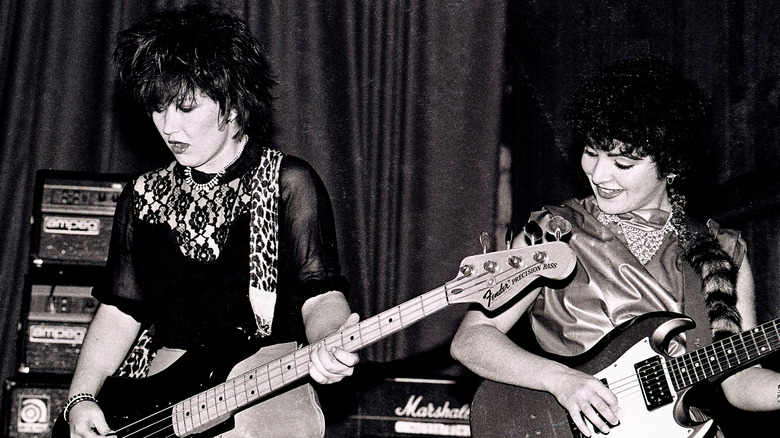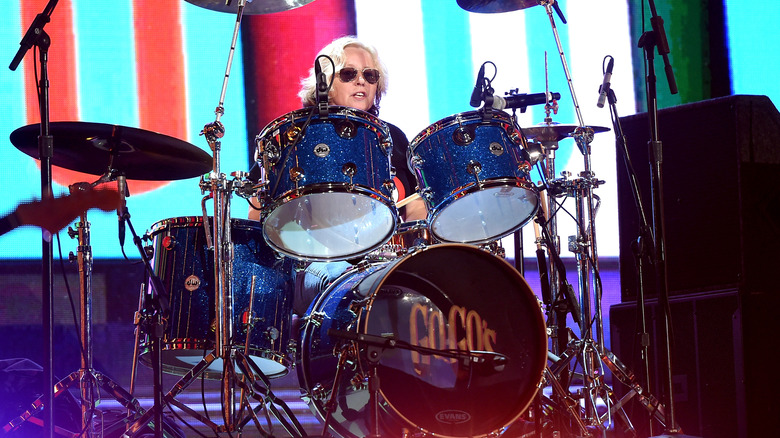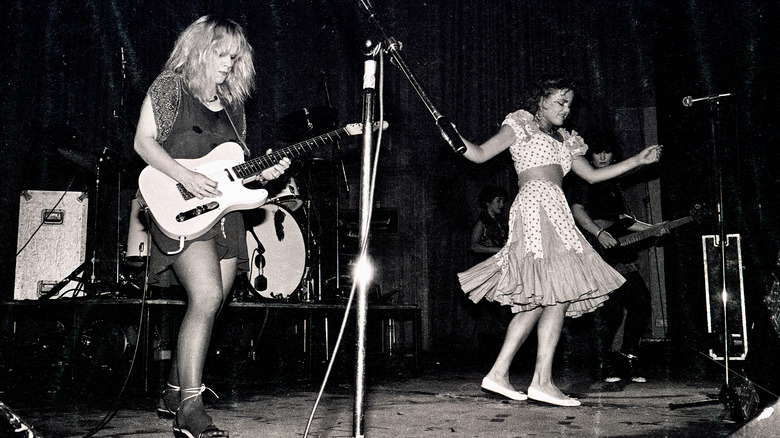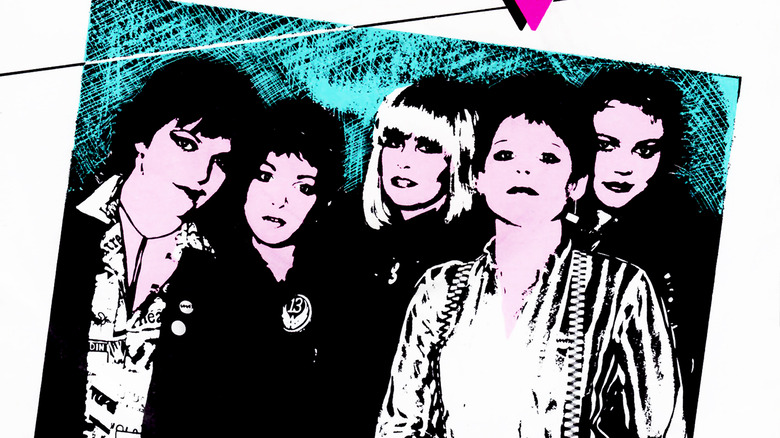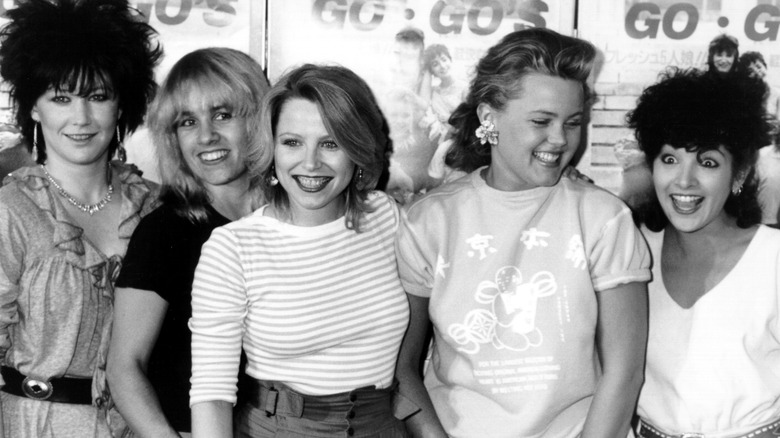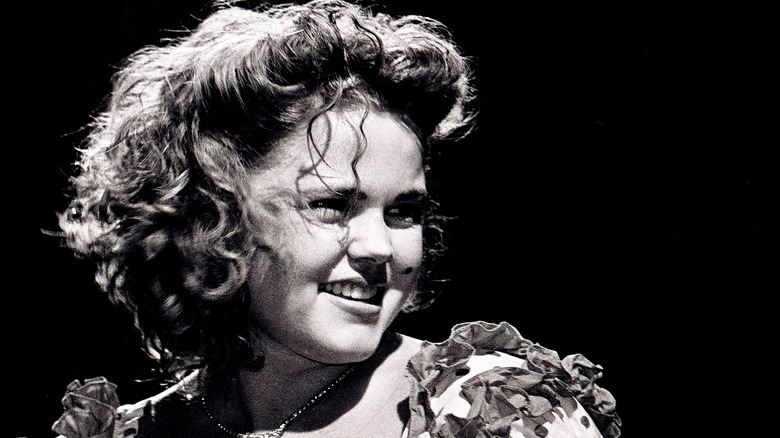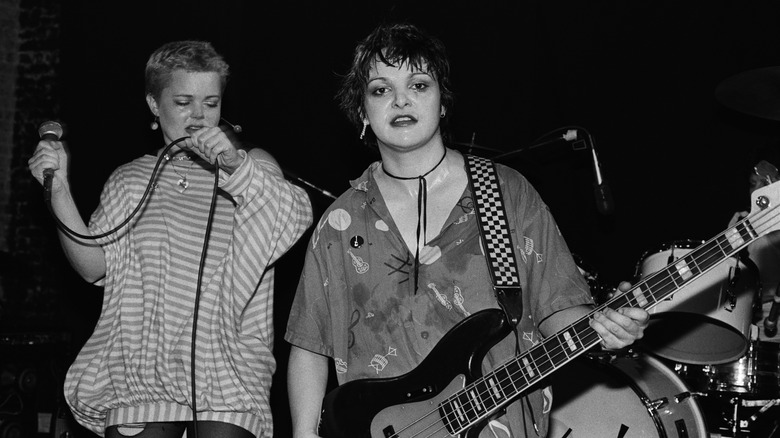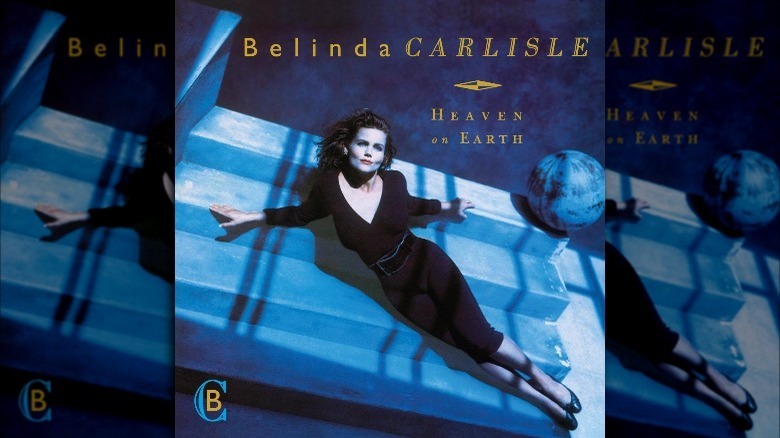The Untold Truth Of The Go-Go's
Here's everything you need to know about the modern music business: The Go-Go's are the most successful all-female rock band of all time, and they released the only No. 1 album written and performed entirely by women — but it took 15 years since they became eligible for the band to be voted into the Rock and Roll Hall of Fame. In fact, it took 15 years for the band to even appear on the ballot.
That lack of respect has hounded the Go-Go's since their earliest days banging out punk songs in grimy Los Angeles clubs, and it continues in many ways to this day. Perhaps their branding and marketing played a role. The Go-Go's' debut album, "Beauty and the Beat," might as well be the official soundtrack of 1981, but to market it, the band sanded off their rough edges, hid their drug addictions, and presented themselves as clean-cut all-American girls who just wanted to dance and play fun music. The fact that they were crafting some of the tightest and catchiest songs of the era kind of got lost in the mix.
Now that the world is waking up to just how great — and how deeply weird — the Go-Go's were, it's time to dig deeper into what made this group of dysfunctional but immensely talented women into one of the most important bands of the rock era. Here's the untold truth of the Go-Go's.
They started off as a rough punk band
If you think of a bunch of smiling young women wearing bathrobes or water-skiing in improbable formations when you think of the Go-Go's, you got played by the marketing gods. The clean-cut, cheerful group of rocker chicks the world saw in 1981 was all fiction. In reality, the Go-Go's began in the raw, chaotic punk clubs of Los Angeles in the late 1970s.
In fact, as noted by the Telegram & Gazette, founding members Margot Olavarria and Jane Wiedlin were inspired to form their own band after seeing the legendarily terrible Sex Pistols concert in San Francisco in 1978 — that's the one famous for Johnny Rotten's sneering taunt of "Ever feel like you've been cheated?" after what may have been the worst punk concert ever. The Go-Go's' lead singer Belinda Carlisle was even in seminal punk band the Germs for a hot minute, according to Vogue. One night at legendary LA club Whisky a Go Go, Carlisle met Olavarria, Wiedlin, and drummer Elissa Bello. They formed a band and began playing at a grimy club called the Masque, which singer Martha Davis described as "dis-gusting."
Far from their cherry pop image, the band cultivated a wild punk rock image and lifestyle. Carlisle performed wearing nothing but a garbage bag while belting out fast, angry punk songs. Los Angeles Magazine reports that the band partied hard in their off time with a lifestyle focused on their "Bootie Club" of male conquests.
The Go-Go's couldn't play their instruments at first
Part of the punk rock aesthetic of the 1970s was a revolt against the overly mannered, blandly professional music dominating radio at the time. Punk songs were often raw and messy, and proficiency on an instrument wasn't particularly highly valued. In fact, rumors that the Sex Pistols didn't even know how to play their instruments abounded, and it inspired plenty of kids to form bands despite not knowing how to play.
That's exactly how it was with The Go-Go's. According to Billboard, Belinda Carlisle once said, "The punk scene was great in that anybody could be in a band and be terrible, including us. ... we had no idea how to play our instruments." Vogue reports that Carlisle also said lead guitarist Charlotte Caffey was asked to join "since we knew she could teach us how to plug our instruments into an amplifier." Los Angeles Magazine confirms that when Wiedlin began looking for a band to join she didn't know how to play guitar at all.
Obviously, they figured it out. Today, part of the band's legacy is the fact that they were one of the first truly successful all-female bands who played their own instruments, something that was somewhat shocking to music fans in 1981.
Drummer Gina Schock was the secret ingredient
When Gina Schock saw The Go-Go's play a show in 1978, she was impressed by their energy and their fun attitude, but not by their playing. Vogue reports that Schock thought, "They weren't quite ready." Not long after, the Go-Go's' founding drummer, Elissa Bello, had to quit the band, and the Go-Go's invited Schock to join them.
Schock had real professional experience. Tom Tom Magazine reports that before Schock moved to Los Angeles, she played in a punk band that had real gigs at places like the legendary CBGB in New York City, and she'd been playing gigs four nights a week in her native Baltimore for years. Schock was surprised to discover the band was only rehearsing twice a month and immediately insisted they start rehearsing and practicing five nights a week at minimum. Schock's influence quickly whipped the Go-Go's into shape.
uDiscoverMusic explains that Schock's drumming chops became a huge creative force in the band. While the other band members had a natural talent for melody and hooks, Schock introduced driving, danceable beats that made the songs distinctive. She was a key ingredient to the band's breakout hit, "We Got the Beat."
Their manager personally financed their disastrous first European tour
When the Go-Go's stabilized with Belinda Carlisle on lead vocals, Gina Schock on drums, Jane Wiedlin on rhythm guitar, Charlotte Caffey on lead guitar, and Margot Olavarria on bass, the band began to gain some traction. The Washington Post notes that in 1980, British ska band the Specials invited the Go-Go's to open for them on their tour of the U.K. The Go-Go's' manager, Ginger Canzoneri, was so determined to make the best of this incredible opportunity that she sold her car and jewelry to fund the tour.
It was a disaster. As Vogue reports, the band expected to find a welcoming punk scene in the U.K., but their sound had begun to evolve into the more pop-friendly hooks everyone knows them for today, and the London-based punk scene wasn't into it. The audience at the U.K. gigs spat on them and shouted insults as they tried to play. In other venues, ska fans were incensed that a non-ska band was onstage.
The tour worked in some degree, though, because when they returned to Los Angeles, there was immense buzz surrounding the band, which eventually led to them signing with I.R.S. Records. This also prompted founding member and bassist Margot Olavarria to leave the band over creative differences. Kathy Valentine was recruited to replace her and had to learn all the songs for the first album over one weekend on "a coke binge."
Being famous almost killed the Go-Go's
The members of the Go-Go's had always been hard partiers who liked their booze and drugs. Although they cleaned up their public image after signing with I.R.S. Records and working on their debut album, "Beauty and the Beat," their poor lifestyle choices actually got worse. A lot worse. In fact, it's amazing that they are all still alive.
As the New York Post notes, the band didn't let professional commitments get in the way of their partying. When they were booked on "Saturday Night Live" in 1981, they started the day with champagne at breakfast and were busily doing cocaine by the time they were due onstage. Drummer Gina Schock says they were "cross-eyed drunk" by the time they performed. Their commitment to the rock-n-roll lifestyle was so strong that when Schock had to have heart surgery to correct a congenital defect, her bandmates took her out for a blowout weekend of booze, mushrooms, and Valium.
Vanity Fair reports that the drugs began to get the better of them — they were soon spending $300 a day on cocaine. The LA Times reports that guitarist Charlotte Caffey became a full-blown heroin addict, and Billboard notes that lead singer Belinda Carlisle was a heavy cocaine user for 30 years, telling the Guardian, "I can't believe I'm not dead."
If you or anyone you know is struggling with addiction issues, help is available. Visit the Substance Abuse and Mental Health Services Administration website or contact SAMHSA's National Helpline at 1-800-662-HELP (4357).
Record labels wouldn't sign the Go-Go's
Perhaps the most incredible aspect of the Go-Go's' story is how long it took them to get a record deal. The Washington Post explains that the band returned from a tour of the U.K. with plenty of buzz, and, according to the AV Club, their first hit, "We Got the Beat," became a breakout hit. Despite all of this, they couldn't get a record deal.
The reason is pretty unsurprising and depressing: sexism. Lead singer Belinda Carlisle believes the band would have had a record deal much earlier if they'd had at least one or two men in the band. She also notes that the head of Capitol Records, Joe Smith, literally told her he loved the band but wouldn't sign them because no all-female band had ever done well enough to justify it.
Only one label was interested — I.R.S. Records, run by the Police's Miles Copeland. The label didn't have a great reputation — Kathy Valentine told Rolling Stone, "I.R.S. was where you went if you couldn't get a deal with a real label." The band held out for a "real" label, but when it became apparent that no one was going to take a chance on a band with five female members, they signed on with I.R.S. in April 1981.
They almost blew their record deal immediately
Recording your debut album is a big deal, and it will set the tone for the rest of your career. You might think that a scrappy young band that finally landed a record deal after years of trying would settle right down to business.
Not if you're the Go-Go's. They loved doing drugs and partying so much that they immediately almost blew their record deal. According to the AV Club, I.R.S. Records signed the band in April 1981 and intended to release their album the following July. The band was given exactly three weeks to record it. But at the end of that three weeks, not even the basic tracks had been recorded. The band was staying in a hotel in New York City, going out every night and closing the bars, then hitting up after-parties until the sun came up. They would then crawl into bed for an hour or two before showing up at the studio at 8:00 a.m., still drunk and quickly sliding into brutal hangovers. Then they'd start drinking and partying in the studio while working before heading out to do it all over again.
They worked with producers Richard Gottehrer and Rob Freeman, who pushed their pop-punk songs much further toward the pop side than the band wanted. When they heard the final product, they were disappointed and angry — at least until the album blew up and became a hit.
The founding member sued everyone
While all five of the band members who played on their debut album were determined to have a music career, it can be argued that the Go-Go's as we know them wouldn't have existed without Margot Olavarria.
The Washington Post reports that it was Olavarria and Jane Wiedlin who initially had the idea of starting a band, bringing in singer Belinda Carlisle and drummer Elissa Bello. Playing bass, Olavarria stuck with the band for three years, taking part in their first major tour and recording "We Got the Beat" for Stiff Records in 1980. But as the band evolved, bringing in ace drummer Gina Schock and guitarist Charlotte Caffey, their sound became more pop and less punk, much to Olavarria's chagrin.
Billboard explains that just before the band finally signed a record deal, Olavarria became ill with hepatitis A, and bassist Kathy Valentine was recruited as a temporary replacement. After just three shows with Valentine, Olavarria was officially fired and Valentine brought in as a permanent member. The Arkansas Democrat Gazette reports that Olavarria saw the Go-Go's as her band and vision and that she reacted to her firing by suing the band and manager Ginger Canzoneri for wrongful termination. The suit was settled in 1984.
Their Broadway musical flopped hard
After breaking up in 1985, the Go-Go's reunited a few times for the occasional benefit concert or to record a song for their greatest hits album. Then, in 1999, they launched a full-on tour, and in 2001, they released their fourth album, "God Bless the Go-Go's." The band's comeback was official. Since then, critical appreciation of the band has slowly risen, culminating in their addition to the addition to the Rock and Roll Hall of Fame in 2021.
But the comeback hasn't been completely smooth. In 2018, the band decided to try their hand at a "jukebox" musical, some of which have found huge success on Broadway in recent years, such as "Mama Mia" and "Rock of Ages." The Hollywood Reporter explains that their production, "Head Over Heels," saw Gwyneth Paltrow make her Broadway producing debut, and that the idea was to couple the shiny pop hits of the Go-Go's with a cute story about a whimsical kingdom whose residents rely on a mysterious magical energy called The Beat.
Deadline reports that trouble started during pre-production, when writer Jeff Whitty of "Avenue Q" fame tried to re-write lyrics to the band's songs, prompting his departure. Then the reviews were pretty savage, and the show struggled to get any traction, only hitting 50% capacity a few times during its truncated run. The show closed in January 2019.
Terry Hall unintentionally co-wrote Our Lips are Sealed
If you were around in the summer of 1981, you might remember the first time you heard "Our Lips are Sealed." The first single from the Go-Go's' debut album, "Beauty and the Beat," the song was instantly popular, reaching No. 20 on the Billboard Hot 100 and a seemingly permanent place on radio playlists.
If you investigate the album notes, you might notice that the song is actually co-written by a guy named Terry Hall, who was definitely not in the Go-Go's. But he didn't co-write the song in the traditional sense, which would involve both parties knowing they were writing a song together. As Pop Culture Experiment explains, Hall was the lead singer for ska band the Specials, who invited the Go-Go's to tour with them in 1980. The Go-Go's' guitarist Jane Wiedlin and Hall began dating, despite the fact that Hall had a girlfriend.
At one point, Hall sent Wiedlin a love letter containing a poem. Wiedlin liked it, added some of her own touches, and turned it into the band's eventual hit single. Far from being irritated that his private thoughts had been made very public, Hall covered the song with his next band, Fun Boy Three.
Their breakup was hella ugly
The Go-Go's were only together in their initial incarnation for about seven years, give or take. And those years were tumultuous. Original drummer Elissa Bello, original bassist Margot Olavarria, and original manager Ginger Canzoneri were all fired and replaced before the band even hit the big time. Then, after the immense success of "Beauty and the Beat," the band couldn't recapture the magic.
The Washington Post reports that sales of their next two albums, "Vacation" and "Talk Show," were disappointing, and the sudden change of fortunes strained the relationships between band members. They began to argue about money, songwriting credits, and expanded roles within the group. Their drug addictions just made things worse.
In 1984, rhythm guitarist and creative force Jane Wiedlin left the band. The New York Post explains that Paula Jean Brown was then brought in to play bass so Kathy Valentine could shift to rhythm guitar, and that Brown was a little shocked at the state of the band she'd just joined. She was especially worried about Charlotte Caffey, whose heroin addiction was in high gear. When Caffey dropped out of the group to commit to her sobriety, she and lead singer Belinda Carlisle decided to end the band, but didn't tell drummer Gina Schock and Kathy Valentine personally, leaving that to their management team.
Jane Fonda got them back together
After their 1985 breakup, the Go-Go's went their separate ways pretty aggressively. Bad blood between the members meant they weren't really talking to each other, and MTV tells us that in 1997 Gina Schock sued her old bandmates, claiming she was cheated out of royalties. Several members pursued solo careers — Jane Wiedlin scored some chart successes in the late 1980s, Belinda Carlisle scored a No.1 solo hit with "Heaven Is a Place on Earth" along with a slew of other hit songs and albums, and Gina Schock formed House of Schock before becoming a successful songwriter for other artists.
With all the drama, it's not too surprising that the band didn't talk to each other (outside of courtrooms) for about five years. What is more surprising is who was instrumental in getting them back in the same room. According to Gina Schock in Forbes, it was none other than actress Jane Fonda.
If that seems a little random, it really isn't: Fonda is well-known as a tireless activist, and her people contacted the Go-Go's in 1990 to invite them to help out with one of her green initiatives in Los Angeles. The five Go-Go's all agreed to participate, so they started talking, and some group dinners were arranged. That led to a brief tour, and more importantly a re-establishment of friendships that ultimately led to the band's reformation and the 2001 album "God Bless the Go-Go's."
